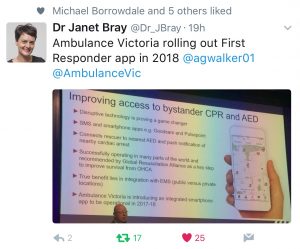The value of Bystander CPR and Public Access AED use is shown nicely in this NEJM article
http://www.nejm.org/doi/full/10.1056/NEJMoa1601891
What does this mean?
I think it means that a sensible approach to out-of-hospital cardia arrest is NOT about hospitals and helicopters (although post ROSC transport and critical care is vital!)
Rather, we need to ensure robust systems such as
– training the public in ‘hands only’ CPR
– making Public Access Defibrillators available as the norm, not the exception
– using smartphone technology to alert and crowdsource trained BLS-providers in the vicinity (such as GoodSAMapp)
– integrate such technology into existing systems
All of which is eminently do-able – and I am pleased to see that some Ambulance Services overseas and interstate have managed to do this
Hoping the remaining Ambulance Services in Australia will be able to follow suit! Word is that New Zealand and Victorian ambulance services will be going live with GoodSAMapp.org in 2018…

Making Communities HeartSafe
Meanwhile at a local level I’ve been busy, along with other concerned clinicians, to ensure our local community becomes ‘Heart Safe’
The Heart Safe community concept is from the USA and again something that would seem relatively easy to apply to Australia.
We’ve pushed ahead in our small Island community to get public access AEDs into the townships, followed by tourist hotspots…..at the same time training community members in hands-only CPR.
Read more about the project at Facebook.com/heartsafeKI & twitter @HeartSafeKI – give us a follow!
Integration with smartphone apps such as GoodSAMapp is also an easy target to achieve.
And if you want to see proof that such a system works, look no further than this local success story from Kangaroo Island.
Read more about Heart Safe Communities here